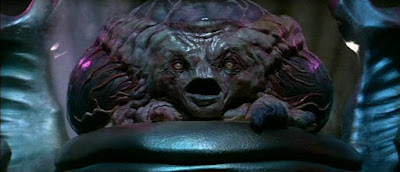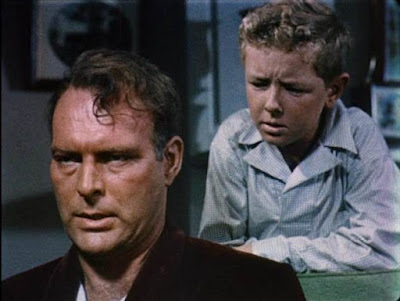In a Lonely Place
(1950) Director Nicholas Ray’s mystery/romance is an unflinching, emotionally
draining experience, punctuated by exceptional performances from Gloria Grahame
and Humphrey Bogart. Bogart plays Dixon Steele, a screenwriter with a volatile
temper who’s accused of killing a hat check girl from a restaurant. While he
remains under the watchful eye of a former army buddy turned police
investigator, he and his neighbor Laurel (Gloria Grahame) fall in love. The question
remains, however: did he or didn’t he? Although In a Lonely Place has some distinctly noir-ish elements, it’s not quite
a noir – more of a character study with a dash of mystery thrown in the mix. Grahame
is captivating as a vulnerable woman reluctant to jump into a new relationship,
but her character doesn’t quite fit in the mold of a femme fatale. Bogie is
also excellent, in one of his most unlikeable and challenging roles as the
verbally and physically abusive Steele.
Rating: ****. Available on Blu-ray and DVD
Beyond the Valley of
the Dolls (1970) “This is my happening and it freaks me out,” proclaims music
producer Ronnie “Z-Man” Barzell (John Lazar), an apt description for this unlikely
collaboration between director Russ Meyer and screenwriter Roger Ebert (yes,
that Roger Ebert). It’s an indescribable, garish candy-hued confection about a girl
group, The Carrie Nations (played by Dolly Read, Cynthia Myers and Marcia
McBroom), and how the members are corrupted by the L.A. party scene. I won’t
bother going into the details of the plot, since they’re largely irrelevant. It’s
best to just take everything in, like a guest at Z-Man’s party.
With its abundance of memorable lines and infectious songs,
I agree with Ebert’s commentary that Beyond
the Valley of the Dolls could have been as big a phenomenon as The Rocky Horror Picture Show. Propriety
dictates that I provide a star rating for this movie, but any objective
evaluation seems to come up short. I’m not sure why it took so long to see this,
but I’m glad I finally took the trip. Unlike 99 percent of everything else out
there, I can honestly assert there’s nothing else like it. Far out, man!
Rating: ***½. Available on Blu-ray and DVD
The Snake Woman
(1961) An interesting premise that fails to deliver on its lurid potential, The Snake Woman suffers from too much
restraint. Susan Travers is fetching as Atheris, a half-human/half-serpent
hybrid, but has far too little screen time, and doesn’t do much more than stand
around. John McCarthy co-stars as Charles Prentice, a rather dim inspector from
Scotland Yard who attracts her with his flute (this sentence has more innuendo
than the whole movie). The film could have gone on so many psycho-sexual tangents,
but director Sidney J. Furie and writer Orville H. Hampton chose to play it
safe. Rather than displaying some sympathy for Atheris, the film sides with her
detractors. A similar concept was explored, much more effectively, by Hammer’s The Reptile. My advice: watch that one
instead, and skip this movie.
Rating: **. Available on DVD (as part of the Timeless Horror – Movies 4 You
collection) and Amazon Instant Video
Amazon Women on the Moon (1987) This hodge-podge of comedy sketches (similar
to Kentucky Fried Movie) from John
Landis, Joe Dante and several other directors misses more frequently than hits.
There are a few amusing skits, including Ed Begley Jr. as a not-so-invisible
man, a parody of Ripley’s Believe it or Not,
and a Siskel & Ebert style review of someone’s life. Unfortunately, too many
segments go on for far too long (especially a funeral sketch), often with very little
payoff. It’s good for a few laughs if you know what you’re getting into, but I
suspect most viewers will be skipping forward.
Rating: **. Available on DVD























